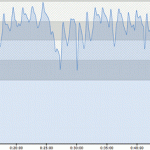If you really want to get down to it, training is about one thing – using a specific energy system. “What’s that” you say. Yes, when you are training, depending on the intensity and duration of the work you are doing, you are using a specific energy system. The result is what you’d expect from your training – development of strength, speed, stamina, weight loss, and muscle mass. However, if you learn to train these systems well, you can start expecting even better results from your time and effort training.

The Systems
To start with, we can divide energy systems into two basic categories: aerobic and anaerobic.
Anaerobic energy systems mean, in very basic terms, that the energy that requires very little to no extra oxygen than what is in the system, at the beginning of an activity, to operate. We tend to think of this system as driving the acts of strength and exercises that are high intensity with relatively short durations. In short, this system is meant for high power and quick movements such as lifting large weights, sprinting, and jumping. Additionally the anaerobic system is associated with strength gains and building muscle such as in bodybuilding.
Aerobic energy systems are those that require great amounts of oxygen to run (pun intended). Aerobic activities such as continuous walking, construction work, hiking, to running and triathlons. This system is associated with endurance activities like already mentioned as well as weight loss.
In a way, we are like hybrid vehicles. One system is a high octane and powerful system for short bursts of energy and acceleration where the other is for the long haul with a more consistent release of energy over a long time and distance. Pretty cool!
The Right Fuel
The anaerobic system is a high-octane system that uses stored energy such as ATP, creatinine phosphate, and lastly muscle glycogen (sugar) and lactic acid. ATP and creatinine are like nitrous oxide or rocket fuel of muscle cells of the body. Unfortunately, these forms of energy come at a high cost and are hard to store, so the body does not store much. These fuels are freely used up in just one second (ATP) to two minutes (lactic acid).
The aerobic energy is derived from muscle glycogen (sugar), fat, and protein. The use of fat is why it is used for weight loss. But, as you can see, aerobic energy can also come from protein, such as your muscle, but only after taxing the system hard and long enough such as in triathlons, marathons, and ultra events.
Muscle glycogen (sugar) and lactic acid are our crossover fuels in exercise as it is used in both systems.
Maybe that means we are the original Crossover Hybrids?
Resetting The System: The Importance of Rest
Now that you have a basic understanding of the systems and their fuels, its important to know how to use them effectively. If the switch to turn on these energy systems is intensity and duration of exercise, then rest is the switch to reset the system so it can be trained again.

Again, this can be simplified. Anaerobic systems must be “hitt” (another pun intended) at very high intensities but for very short durations. Likewise, the rest for this system is relatively short, 2–30 min, compared to aerobic systems which need 30min or even days to recover.
Just to beat a dead horse, aerobic energy systems take much lower intensity levels (above 60% of max) over a longer time (at and above 30min for a rule) to kick in.
Remember, these energy systems are not one shot deals and can be reactivated as frequently as the fuel is available. But, if adequate rest is not given to a system to reset, you can find yourself moving out of your intended training energy system and into another. You can go from anaerobic bodybuilding to aerobic fat burning without simply resting about 4 minutes. Or worse, you can go from burning fat to lose weight to destroying muscle. What a waste of time!
Summing It All Up
| Energy System | Classification | Energy Source | Duration | Heart Rate % | Exercise Type | Rest |
|---|---|---|---|---|---|---|
| ATP+CP | Anaerobic | Muscle ATP Stores | 1 – 4 sec | 105 – 125% Max Training HR | Strength Training/Weightlifting and Sprinting | 2 – 5 min |
| Muscle ATP & CP Stores | 4 – 20 sec | |||||
| Anaerobic/ Lactic Acid | Anaerobic | Muscle ATP, CP, & Glycogen Stores | 20 – 40 sec | 90 – 105% Max Training HR for >60sec | Lactate Threshold Training, Hard long runs, Fartlek runs, kettlebell sport | 30 min – 1 hr |
| Muscle Glycogen Stores & Lactic Acid | 40 – 120 sec | |||||
| Aerobic | Aerobic | Muscle Glycogen Stores & Fatty Acids | 2 – 40 min | 60 – 90% Max Target HR | Walking, long duration runs, hill climbing, Manitou Incline, Kettlebell sport, aerobic class | 2 hrs – 2 days |
| 40 – 120 min | ||||||
| Muscle Glycogen Stores & Protein | 2 – 3 hrs |
Adapted with permission from: Nathanael Morrison, 2013 Combat Conditioning; Vol 1, Edition 2.0, pgs. 25–28, 44 & 51; CombatConditioning.org
If you come to understand the above chart and how to use it in your training, you are learning to push just the right button at just the right time with just the right force and for the just the right amount of time. The way we like to coin this is Effective Minimum Dosage of exercise – maximal results with minimum effort/time.
Its not being lazy, just highly efficient!
You should also be able to see that this model also points to why most of us are not getting the results we should. For example, without the proper rest interval, your strength training becomes lactate threshold training. This is not a bad mode to train in, but if its not what you intend to do, your wasting time doing something you didn’t intend to. Frustrating!
In the upcoming weeks we will be discussing how popular exercise violates energy system training and why most people might be wasting their effort, time and money training poorly.
Image References
- Wind Power by Håkan Dahlström
- Reset Button by Greg McMullin




Want to discuss? Join the conversation CubeDwellerFitness's Facebook Page.